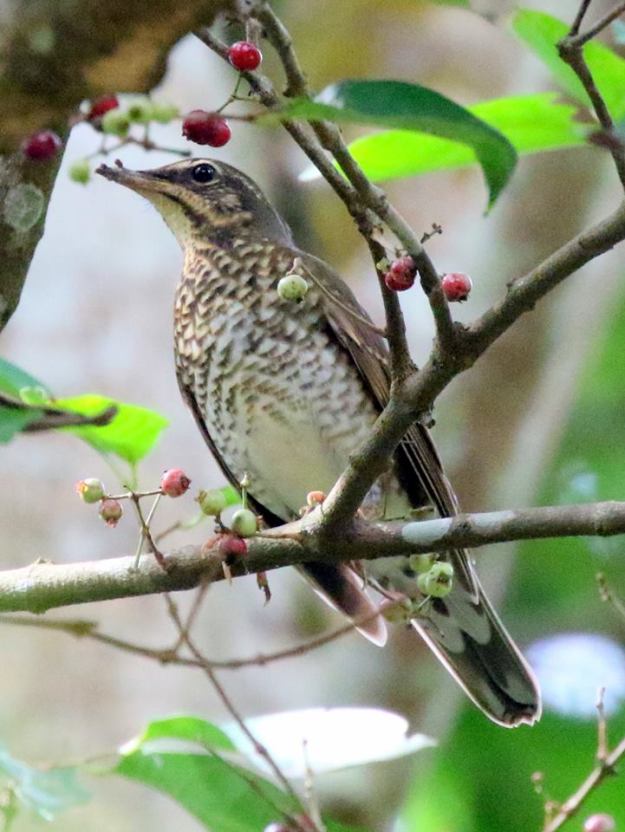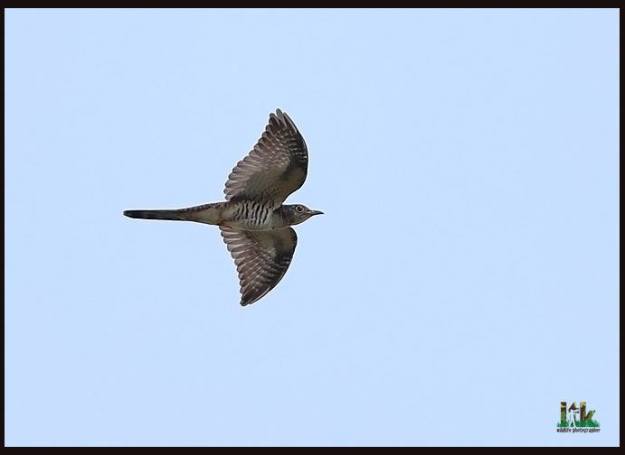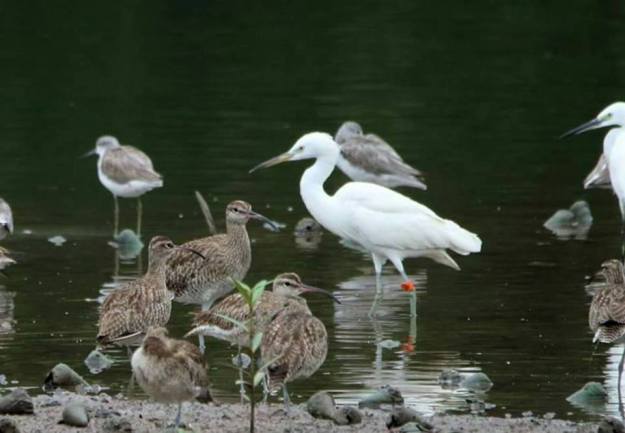
Bulwer’s Petrel photographed by Lau Jiasheng on a pelagic trip to the Straits of Singapore.
The big new for November had to be the sighting of a Bulwer’s Petrel Bulweria bulwerii on 12th at the Straits of Singapore during a pelagic trip organised by Francis Yap and friends. This is the first encounter with this petrel and a very important find. It showed that they are using the Straits of Singapore to move from their breeding grounds at the islands off Japan and SE China to the warmer waters of the Indian Ocean. (Note: the Singapore Straits is a multi-national stretch of water). The Records Committee is now assessing this record. During the same trip a rare Red-footed Booby Sula sula was photographed resting on flotsam. This is only the third record. Well done guys!

Red-footed Booby, the third record of this species, at the Straits of Singapore photographed by Francis Yap.
With more and more observers, and people interested in birds, we are getting records of arriving thrushes, pittas, cuckoos and flycatchers from every corner of the island this month. This in turn gave us a very accurate picture of the movement of these migrants, data which is crucial for their conservation.
The Hooded Pitta Pitta sordida records for this month best illustrate this. Saket Sarupria posted a photo of one at the corner of a stair landing at Keppel Towers on 29th. It flew off later on its own. But the second sighting of the day at St. Andrew’s Cathedral survived the crash as well (David Tan). The next day, Sarah Chin’s dad found one at the PWC building at Chinatown. David Tan was kept busy going from Bedok North and then to King George’s Avenue to collect two more dead Hooded Pittas on the same day. The last Hooded Pitta for the month was at Tuas South, seen very much alive by Robin Tan. The five pittas found in that two days gave us a timing of its major movement. But it was the report of a Hooded Pitta that crashed into Patricia Lorenz’s house at Tanah Merah on 6th that sets a new extreme date (David Tan).

Blue-winged Pitta looking lost in the grounds of Bowen Secondary School. Photo: Jimmy Lee.
The Blue-winged Pittas Pitta moluccensis continued to arrive this month. One found dead at Orchard Road on the 1st (David Tan), another casualty at Tuas on 3rd. Low Choon How reported one at Tuas South on 9th, another was photographed roosting at night at Hindhede NP by Vinchel Budihardjo on 11th. James Tann reported another crashing into Metropolis at One-North on 11th as well. This one survived. The last was seen wandering around Bowen Secondary School by Jimmy Lee on 18th. Pittas are one species that are very prone to crashing into buildings during night migration.

Siberian Thrush feeding on the berries outside the BTNR Visitor Center. Photo: Lee Chuin Ming.
Up to three Siberian Thrushes Geokichla sibirica were first seen feeding on a fruiting tree near to the BTNR visitor center on 2nd by Lee Chuin Ming. This was followed by the appearance of the Eye-browed Thrush Turdus obscurus at Bidadari spotted on the same day by Timothy Lim. More Eye-browed Thrushes were seen at Tuas South on 30th by Koh Lian Heng and Robin Tan.

A surprise find at the Marina Barrage by Koh Lian Heng, a female Blue Rock Thrush.
The surprise find was a female Blue Rocked Thrush Moniticola solitarius at Marina Barrage by Koh Lian Heng on the 6th. This thrush normally prefers to perch at high buildings in Singapore. On the same day, Low Choon How recorded up another Siberian Thrush at Tuas South.

First arrival of the season, a male Mugimaki Flycatcher photographed at Tuas South by Adrian Silas Tay.
The Ferruginous and Mugimaki Flycatchers were late by more than a month this season. First record of a Ferruginous Flycatcher Muscicapa ferruginea came from the Zoo on 6th (Loke Peng Fai) and another at West Coast Park (Lim Kim Keang). This is the first record for West Coast Park. We managed to have three Mugimaki Flycatchers Ficedula mugimaki all arriving on the same day, 27th, at three different sites. Tuas South by Adrian Silas Tay, Pasir Ris Park by Lim Kim Seng and DFNP by Art Toh. These records almost nailed the date of the influx of this flycatcher.( Footnote: Received an update from Lim Zhong Yong that he photographed a Ferruginous Flycatcher on 29th October along the Rail Corridor near BTNR)

This first winter male Blue and White Flycatcher came down to forage at the Acacia grove at Bidadari giving Lim Kim Keang this eye level side profile image. First seen by Er Bong Siong.
Another late arriving flycatcher was the rare Blue and White Flycatcher Cyanoptila cyanomelana. We have yet to separate it in our checklist. Lee Van Hien photographed one at the favourite migrant stop over at Tuas South on 12th after a tip from his friends. Two days later Keita Sin had one flying over Jelutong Tower. Inevitably a first winter male was found at Bidadari foraging on the acacia groves on 15th (Er Bong Siong). The fourth record was another first winter male photographed at DFNP by James Tann on 27th. Four records for one month is not usual. Most stayed around for a few days.
The male Japanese Paradise Flycatcher Terpsiphone atrocauda at the Zoo entertained us for about a week. It was last seen on 6th. A week later on 13th Geoff Lim found another there, this time a female. One more female turned up at Bidadari on 18th (Lim Kim Keang) and could be the same female reported by Dawn Birding on 30th. We hope that this rare and beautiful flycatcher will return to our shores year after year.
Hodgson’s Hawk Cuckoos Hierococcyx nisicolor arrived only in November. First one was seen at Tuas South, where else, by Low Choon How on 9th ( rather early), the second at SBWR on 13th by Lim Kim Seng and the third on 26th at Tuas South again. A day later we had our first record of the Large Hawk Cuckoo Hierococcyx sparverioides at Bidadari (Goh Cheng Teng).
West Coast Park seems to be a favorite stop over for kingfishers this season. Keita Sin flushed a Oriental Dwarf Kingfisher Ceryx erithaca there on the 3rd. Alan OwYong photographed a returning Black-capped Kingfisher Halcyon pileata near the big drain on the 5th. Then Lim Kim Keang stumbled on a Ruddy Kingfisher Halcyon coromanda on the 6th while looking for the Black-capped. A Squared-tailed Drongo Cuckoo Surniculus lugubris was also wintering there since the 5th (Alan OwYong). All these (except for the Black-capped King fisher) were new for West Coast Park.

A rare shot of an Indian Cuckoo in flight captured by Lee Tiah Khee over Tanah Merah Grasslands on 12th.
Other notable visitors reported were a Grey Nightjar Caprimulgus jotaka found at a Jurong warehouse on 9th (Lim Kim Chuah), an Indian Cuckoo Cuculus micropterus at Tanah Merah Grasslands on 12th (Lee Tiah Khee), Ruddy Kingfisher at Bidadari on 14th (Simon Siow), Cinereous Bulbul Hemixos cinereus heard at BTNR on 23rd by Lim Kim Chuah, two White-shouldered Starlings Sturnus sinensis at SBTB on 26th by Koh Lian Heng and a Crow-billed Drongo Dicrurus annectans at Tuas South on 26th by Lim Kim Keang.
Four resident species were recorded for the first time in their respective locations. A lone Glossy Swiftlet Collocalia esculenta over Telok Blangah Hill on 6th (Alan OwYong), Red-wattled Lapwing Vanellus indicus at Murnane Reservoir on 11th (Seng Beng), an adult Javan Munia Lonchura leucogastroides with three juveniles at Kovan on 12th (Seng Beng) and Thick-billed Pigeon Treron curvirostra at GBTB on 26th( Kok Lian Heng). An indication of the spreading of these species from their usual habitats?
Shorebirds recorded this month included Bar-tailed Godwits Limosa lapponica, globally threatened Great Knots Calidris tenuirostris at SBWR 0n 3rd (David Li), two Sanderlings Calidris alba again at Pulau Tekong on 6th (Frankie Cheong), a Red-necked Stint Calidris ruficollis at Marina Barrage on 5th (Liz How) and a Common Snipe gallinago gallinago at NTL 3 on 14th (Lim Kim Seng). The numbers for snipes is poor this season.

Black Bittern at pond at Kent Ridge Park, a first for this site. Photo: Veronica Foo.
Waterbirds included one dead and another live Von Schrenck’s Bittern Ixobrychus eurthythmus . David Tan picked up the dead bittern at Jurong West on 5th and Seng Alvin shot a confiding bittern at PRP on the 7th. The first Black Bittern Dupetor flavicolis for the season was captured by Veronica Foo at the pond at Kent Ridge Park on 22nd. This is new for the park. A second Black Bittern was reported from Tuas South on 26th by Lim Kim Keang. The month ended with an exciting find, a Chinese Egret Egretta eulophotes at SBWR by Lee Kai Chong. It had a red ring attached to one of its leg. David Li is still trying to find out where it was ringed.

The Chinese Egret in question shot at Sungei Buloh Wetland Reserve by Lee Kai Chong.
Legend: BTNR: Bukit Timah Nature Reserve. DFNP: Dairy Farm Nature Park. GBTB: gardens by the Bay. PRP Pasir Ris Park. NTL 3 Neo Tiew Lane 3.
Lim Kim Seng. The Avifauna of Singapore. 2009 Nature Society (Singapore).
Yong Ding Li, Lim Kim Chuah and Lee Tiah Khee. A Naturalist’s Guide to the Birds of Singapore. 2013. John Beaufoy Publishing Limited.
Craig Robson. A field Guide to the Birds of Thailand and South East Asia. 2000.
A Field Guide to the Waterbirds of Asia. Wild Birds Society of Japan. 1993
This report is compiled by Alan OwYong and edited by Tan Gim Cheong from selected postings in various facebook birding pages, bird forums and individual reports. Some were not verified. We wish to thank all the contributors for their records. Many thanks to Lau Jiasheng, Francis Yap, Lee Chuin Ming, Koh Lian Heng, Adrian Silas Tay, Lim Kim Keang, Lee Tiah Khee, Veronica Foo and Lee Kai Chong for the use of their photos. If you have any earlier records than those reported here and found some errors, please notify alan.owyong@gmail.com.


















